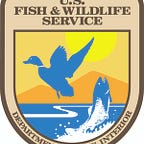When Harry met Salmonberries: A Guide to Wildlife-Friendly Yards
By Sarah Levy, Public Affairs Officer for the U.S. Fish and Wildlife Service
There’s a scrub jay that hangs out in my neighbor’s yard. I named him Harry. Harry revels in foraging for snacks, sitting on fences, and flying short distances to screech with his bird friends. I’m not totally sure that the Harry I see one day is the same Harry that I see the next day, but does it matter? Harry is my little blue buddy.
My neighbor’s yard has a wild, untamed aesthetic. There is trillium, Oregon grape, wild salmonberries, milkweed, and even blueberries growing in plumes. These plants are frequented by bees and squirrels, butterflies, worms, and spiders. The flowers and insect-friendly plants are tended to by pollinators and birds in the summer, and other wildlife use them for food and shelter in the winter.
Their yard is designed as a wildlife-friendly yard, or a backyard habitat. Backyard habitats are designed to create wild space for birds, pollinators, and other animals to flourish. These micro ecosystems are particularly important in urban areas and contribute to green corridors that support migrating wildlife.
My yard, on the other hand, doesn’t have nearly as much wildlife. I chose plants mostly based on an easy maintenance regime and year-round color. Some of the plants are native (Oregon stonecrop, for example), and some are not. I inherited a yucca, a plant that reminds me of where I grew up. My yard is lovely, but it doesn’t attract nearly as much wildlife as a yard specifically designed as habitat.
Here are some suggestions for how you can create a wildlife-friendly yard (and one that is colorful year-round, too!). They’re easy, low maintenance, and you might be able to make a friend like Harry.
1. Water: Just like humans, wildlife need water to survive. Bird baths are just what they sound like: little pools where birds, bees, and other animals can clean themselves. Rain gardens, ponds, or other intentional spaces for collecting water work just as well. Water your plants in the mornings or evenings, check your hoses for leaks, adjust your sprinklers so that they water your gardens and not the sidewalks, and minimize your lawn footprint.
2. Food: Fruit and seeds are a forager’s delight. A basic tray on a post with seeds and nuts can attract all kinds of songbirds. Suet feeders are particularly enticing to birds like woodpeckers, chickadees, and nuthatches.
3. Shelter: Animals need shelter to survive in hot weather, cold weather, and the elements in between. Remember what I said about that wild, untamed aesthetic? It’s that wildness that creates spaces where wildlife can build nests. Tree stumps, unpruned plants, fallen logs, plants grown in clumps can act as homes for animals throughout the winter. Let your yard fly its freak flag. It makes for perfect habitat. There are also bird houses you can build for specific birds like woodpeckers, robins, and barn swallows. A yard safe for birds is also one free of cats; consider keeping your kitty indoors, in a catio, and cat-proofing your yard.
4. Plants for pollinators: Pollinators play a critical role in creating the food we eat and drink, as well as supporting your vegetable garden, flowering plants, and that blueberry bush that keeps you well stocked in fruit and jam. Native flowering plants like goldenrod and yarrow attract bees and other pollinators. You can even grow sunflowers!
5. Avoid pesticides: You know those bees that support us? Their numbers are dwindling, in part because of the use of pesticides. You can avoid pesticide use in your yard by using compost to build healthy soil, planting native plants and using non-toxic bug bait. You also may need to get out there and pull some weeds by hand, but why not soak up some vitamin D?
There are a number of organizations that can support you in building wildlife-friend yards, including the Audubon’s Backyard Certification Program. Local nurseries will often help you pick out plants that will attract bees and pollinators year-round. Ask your neighbors and friends who may have habitat-friendly certifications, or have yards that look like they might belong in a National Wildlife Refuge.
That’s what I did with my own neighbors, and now Harry visits me all the time.
